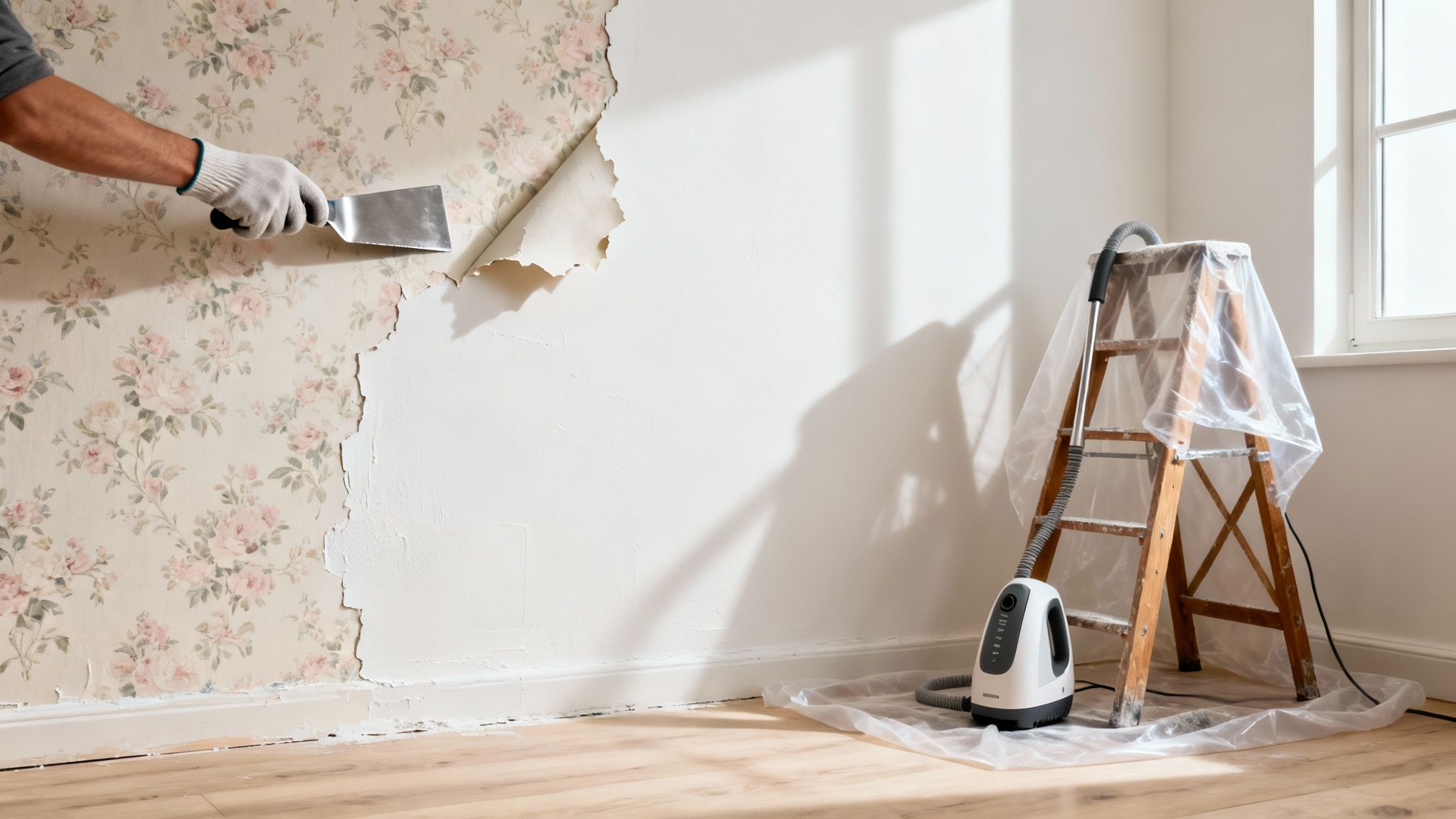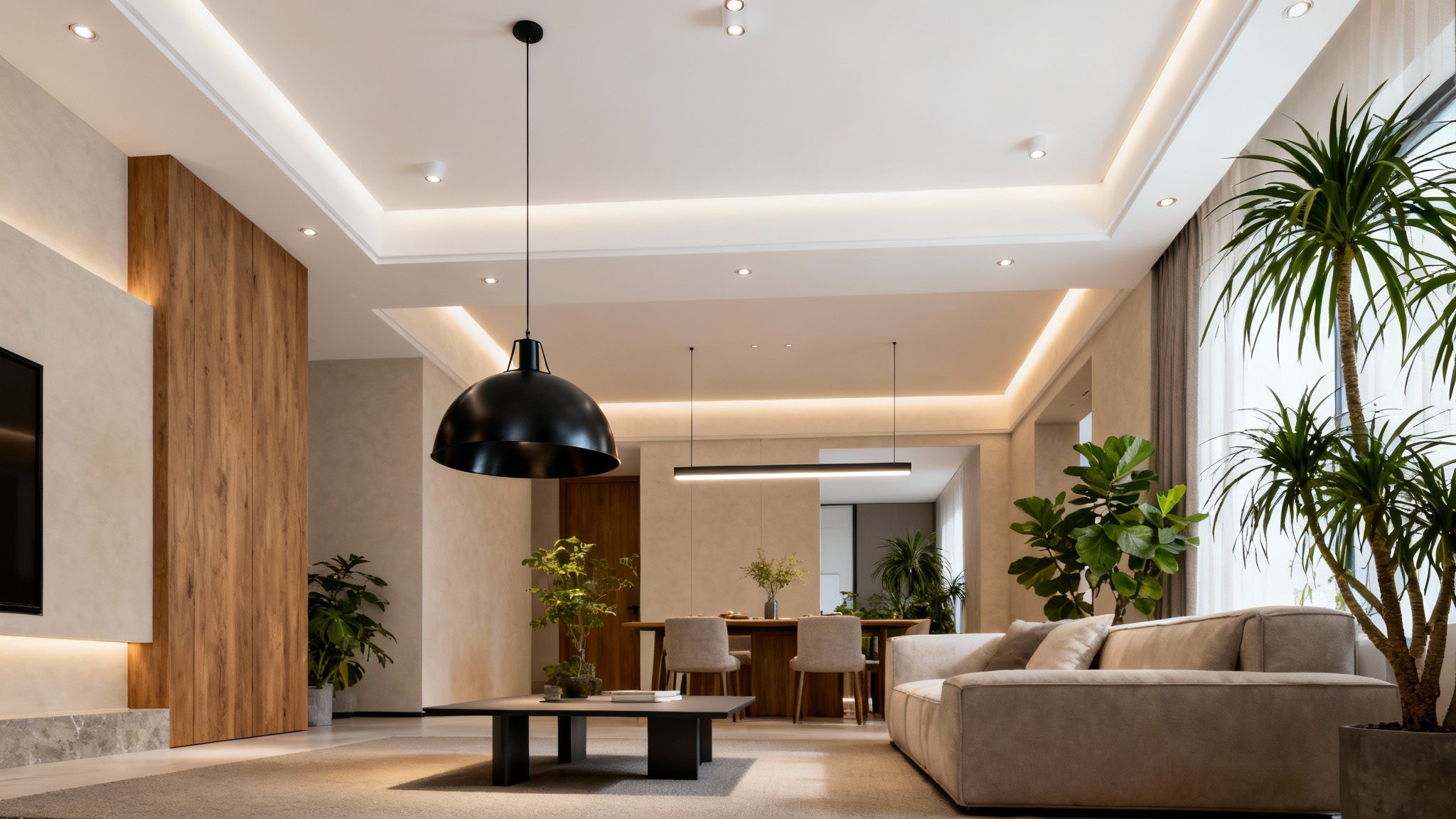Your kitchen island is so much more than a place to chop vegetables. It’s the real hub of the home, isn't it? It’s where you prep meals, eat casual dinners, help with homework, and sip your morning coffee. Because it plays so many roles, getting the lighting for your kitchen island right is absolutely essential. The perfect fixtures don't just light up the space; they set the mood, make the island more useful, and pull your entire kitchen design together.
Why Your Island Lighting Is So Important
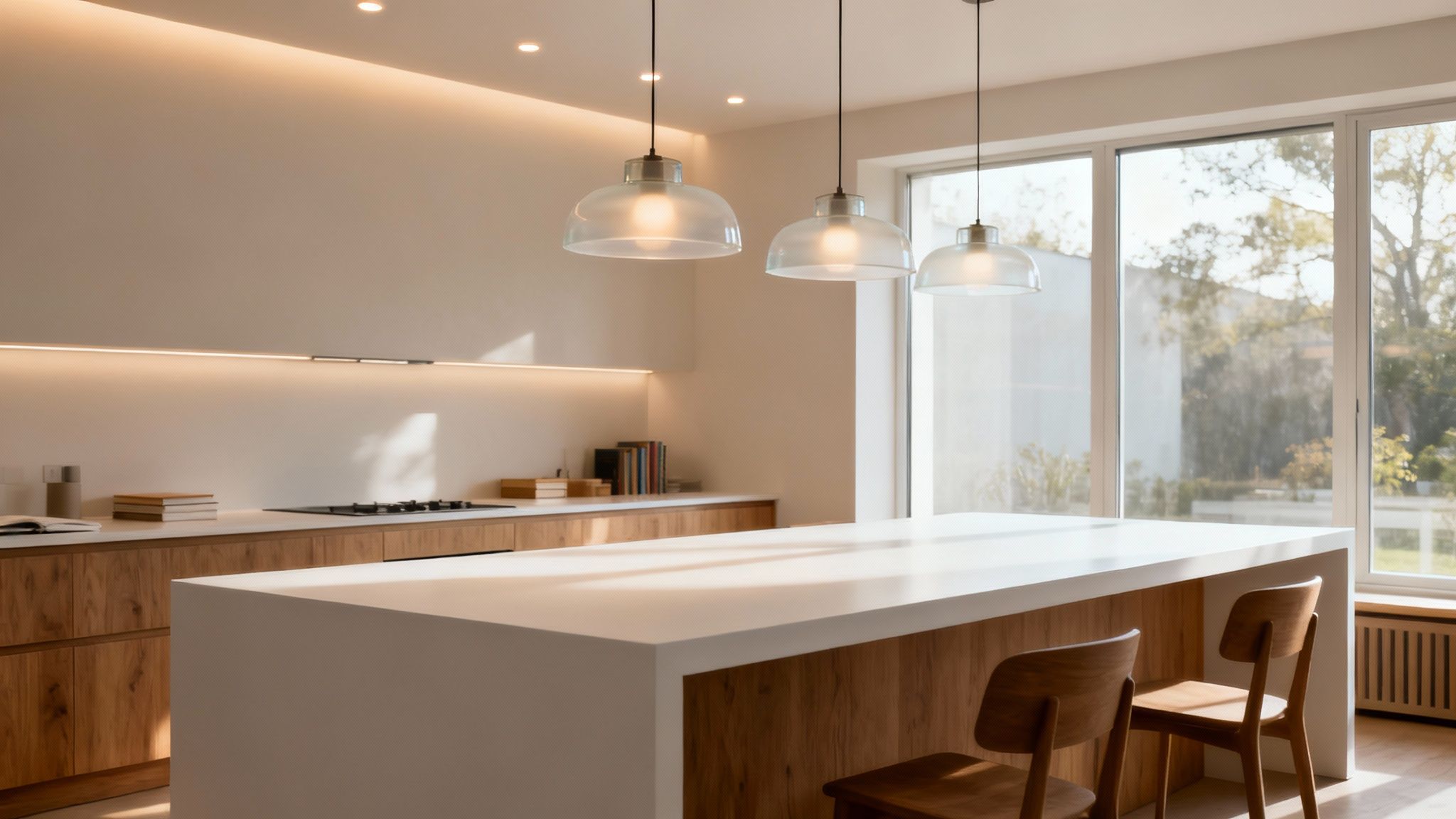
I always tell my clients to think of their kitchen island as a stage where all the daily action happens. Without the right spotlight, you're not getting the most out of it. Poor lighting casts annoying shadows over your workspace, which not only makes tasks harder but also creates a drab, uninviting atmosphere. Nobody wants that.
On the flip side, well-chosen lighting can completely transform an island into a stunning and practical focal point. It's the ideal spot to use a technique I swear by called layered lighting. This approach simply means combining different light sources to build a balanced, flexible, and beautifully lit space. It's truly the secret to a high-functioning kitchen.
The Power of Layered Lighting
Layered lighting isn't some fleeting design trend; it's a genuinely practical way to light a modern kitchen. It’s all about blending three specific types of light to cover all your bases.
- Ambient Lighting: This is your general, all-over light that fills the room. It’s the foundation that provides a comfortable base level of brightness. Usually, this comes from recessed ceiling lights.
- Task Lighting: This is the focused, direct light you need for specific jobs. Over a kitchen island, it’s critical for safely chopping food, reading recipes, or any other detailed work. Pendants and linear fixtures are perfect for this.
- Accent Lighting: This is the fun part! Accent lighting adds a bit of drama and personality, highlighting design features like a beautiful splashback or open shelving. Think of subtle under-cabinet strips or tiny spotlights.
When you combine these layers, your kitchen island becomes incredibly versatile. You can have bright, clear light when you're prepping a big family meal, then dim the pendants down to a soft, ambient glow for a relaxed dinner. If you’re dealing with a particularly gloomy space, you can find more tips on how to brighten a dark room in our detailed guide.
Good island lighting is the ultimate multitasker. It needs to be practical enough for chopping onions yet atmospheric enough for sharing a bottle of wine. Achieving this balance is what turns a good kitchen into a great one.
Looking ahead, UK kitchen design trends for 2025 are really leaning into this layered approach, and the island is centre stage. In fact, studies from UK design firms show that properly layered lighting can improve a kitchen's functionality by as much as 40%, particularly for food prep. This marriage of style and substance is precisely why focusing on your island's illumination is one of the smartest design decisions you'll make.
Finding the Perfect Fixture for Your Kitchen Style
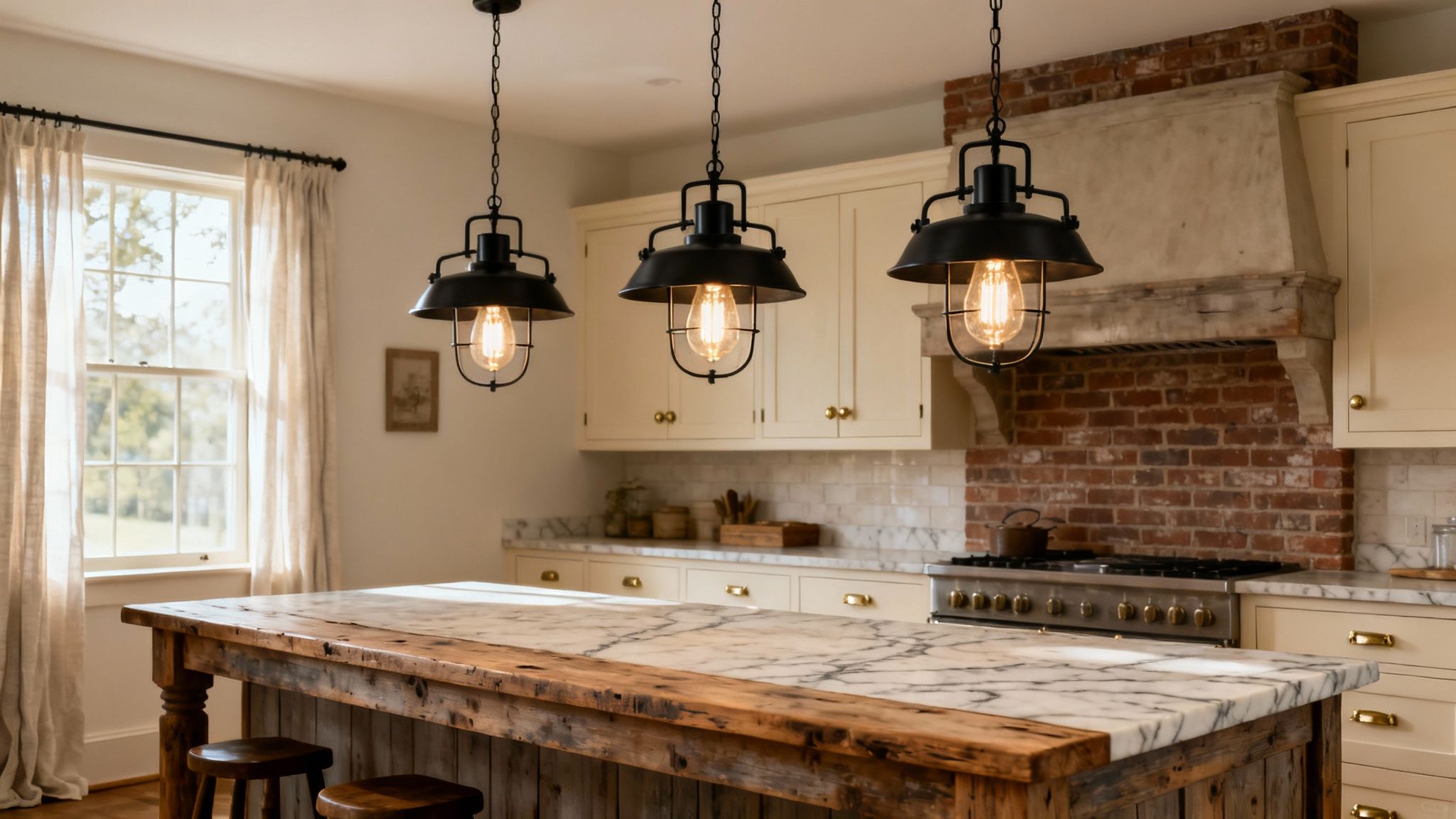
Choosing the right light for your kitchen island is less about rigid rules and more about finding a fixture that truly reflects your style and how you use the space. Think of it as the room's centrepiece—it needs to provide fantastic task lighting, but it also has the power to pull your entire kitchen design together.
Let’s move beyond generic advice. Picture a long, rustic island with a reclaimed wood worktop. You can almost see how three industrial-style metal pendants, maybe in a matte black or an aged brass finish, would look incredible hanging above it. They'd cast focused light for chopping and prep work while adding a touch of edgy character.
Now, imagine a completely different kitchen: sleek and modern with a minimalist waterfall island. Here, a single, sculptural linear suspension light creates a clean, uninterrupted focal point. This approach gives you brilliant, even illumination across the whole surface without any visual clutter, perfectly echoing the kitchen’s contemporary vibe.
Exploring Popular Fixture Types
The sheer variety of fixtures can feel a bit overwhelming, but most options fall into a few key categories. Getting to know their strengths will help you quickly narrow down the search for the perfect fit.
Pendant Lights: By far the most popular choice for kitchen islands, and for good reason. They hang from a single cord and can be used alone over a small island or grouped in sets of two, three, or even five for larger ones. Their versatility is unmatched, with styles ranging from delicate glass globes to bold, oversized domes.
Linear Suspension Lights: This style features multiple light sources on a single long fixture. It’s a fantastic solution for long, rectangular islands because it provides consistent light from one electrical point, which can simplify installation.
Chandeliers: Once strictly for dining rooms, chandeliers are now making a bold statement over kitchen islands. A modern, multi-arm chandelier can bring a dose of glamour and sophistication, instantly elevating your kitchen’s design.
In the UK, the trend has firmly cemented pendants as the go-to for kitchen islands. Looking ahead to 2025, it's clear they're valued not just for task lighting but as a crucial design element that builds those essential ambient and accent layers.
For the best results, I always advise clients to hang pendants around 75 to 85 cm from the worktop. This hits the sweet spot between great illumination and keeping your sightlines clear across the island.
Your island light fixture is a real chance to express your personality. Decide early on if you want it to be a subtle, supporting player or the star of the show. Both approaches can work beautifully—the key is to be intentional with your choice.
Kitchen Island Light Fixture Comparison
To help you visualise which fixture might work best for you, I've put together a quick comparison of the most common types. This table breaks down what each is best for and the styles they typically complement.
Ultimately, the right fixture comes down to balancing the scale of your island with the overall aesthetic of your kitchen.
Making a Statement or Aiming for Subtlety
The fixture you choose will either command attention or offer understated elegance. There’s no right or wrong answer; it’s all about the look you’re aiming to achieve in your home.
A series of striking crystal pendants or a large, artistic chandelier will naturally draw the eye and become a major talking point. In contrast, simple glass globe pendants or a slimline linear fixture can blend more seamlessly, allowing other elements like your beautiful worktop or bespoke cabinetry to take centre stage. If you're looking for more inspiration on how lighting fits into the bigger picture, have a look at our guide to stunning kitchen island design ideas.
How to Space and Hang Your Island Lights
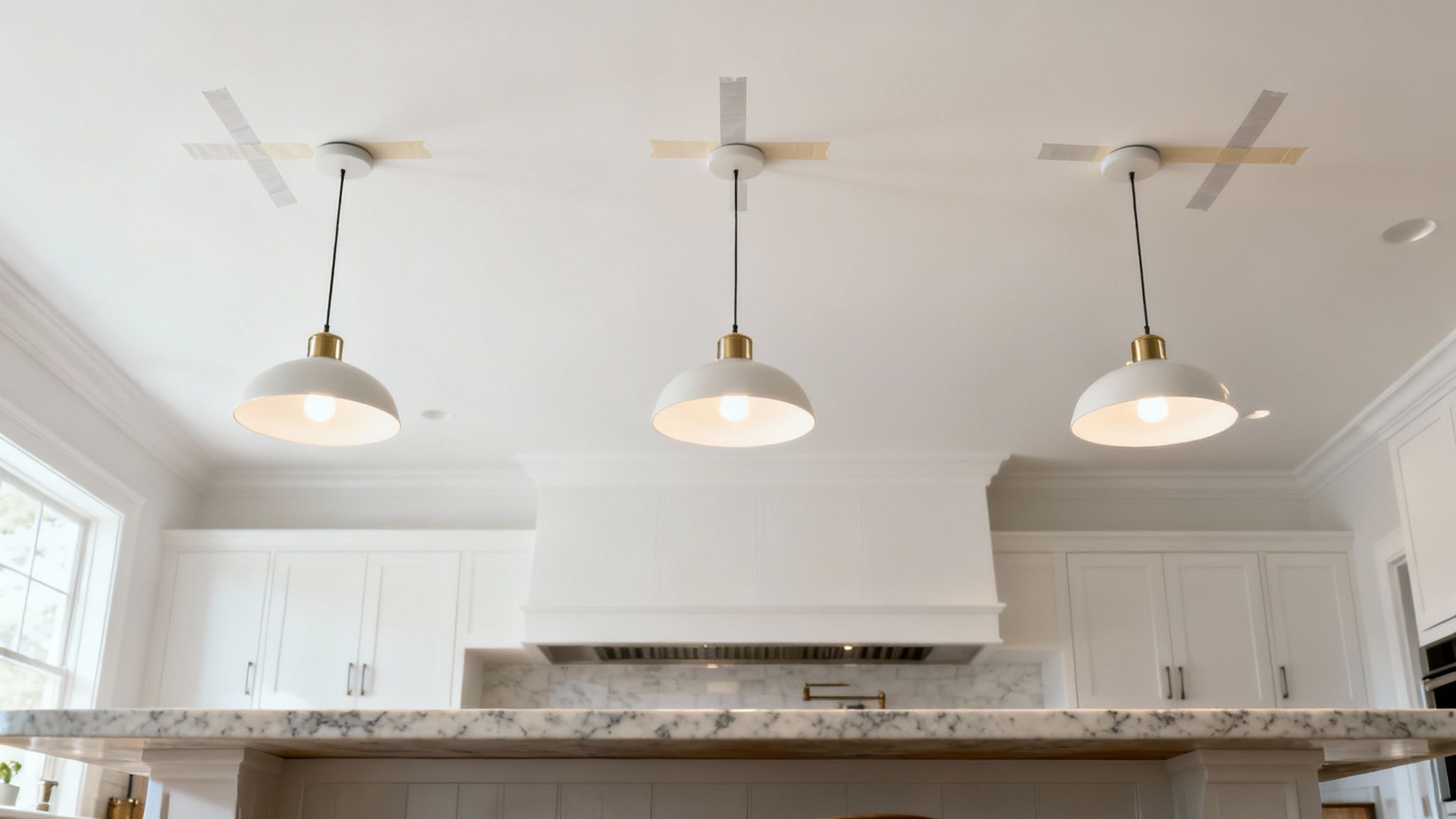
You’ve found the perfect fixtures, but the real secret to getting that polished, professional look lies in how you place them. Getting the height and spacing of your lighting for kitchen islands just right is what truly separates a good design from a great one. It’s the make-or-break detail that defines a functional, beautiful space.
The most critical measurement? The height. Hang them too low, and you immediately create a visual barrier, blocking sightlines and making the space feel cramped. Hang them too high, and they lose that focused, task-oriented purpose, looking a bit lost and disconnected from the island below. The goal is to hit that sweet spot right in the middle.
Mastering the Height
As a solid rule of thumb, the bottom of your pendant lights should hang somewhere between 75 to 85 cm (about 30-34 inches) above the island worktop. This height is ideal because it illuminates your prep area perfectly without forcing anyone to duck to see across the room. It also keeps the fixtures low enough to be a key part of your design scheme.
Of course, this is a guideline, not a strict rule. You’ll want to adjust based on your own kitchen:
- Your Family's Height: If you're a taller household, you might want to nudge the lights towards the higher end of that range to keep sightlines completely clear.
- Fixture Size: Large, statement pendants can often be hung a little higher so they don't feel too overwhelming.
- Ceiling Height: With very high ceilings, you have the flexibility to hang your lights a bit higher, which helps everything feel more balanced and proportional.
Perfecting the Spacing
Once you’ve dialled in the height, it’s all about spacing. An uneven arrangement can throw off the balance of the entire kitchen. My go-to method for this is a classic for a reason: the 'rule of thirds'. It creates a naturally harmonious layout every time.
Think of it this way: divide your island's length into imaginary sections. If you're hanging two pendants, you'd split the island into thirds and hang a light at the one-third and two-thirds marks. For three pendants, you'd divide it into quarters, placing a light at each of the centre quarter marks.
A simple tip I always give my clients is to use painter's tape on the ceiling to mark out the exact positions before you even think about drilling. You can even hang balloons from the tape to get a feel for the size and height. It’s a tiny bit of effort that helps you visualise the final look and avoid some very permanent mistakes.
Another measurement to keep in mind is the distance from the edge of the island. You'll want to leave at least 15 cm (6 inches) from the end of the worktop to the edge of the light fixture itself. This stops the arrangement looking squashed and makes sure the light is cast over the main workspace, not spilling over the sides.
If you’re looking for more inspiration, you might find some great examples in these creative lighting ideas for your home. Taking a little extra time to measure and plan will ensure your lighting is not just beautiful, but perfectly positioned for real life.
Getting the Brightness and Colour Spot On
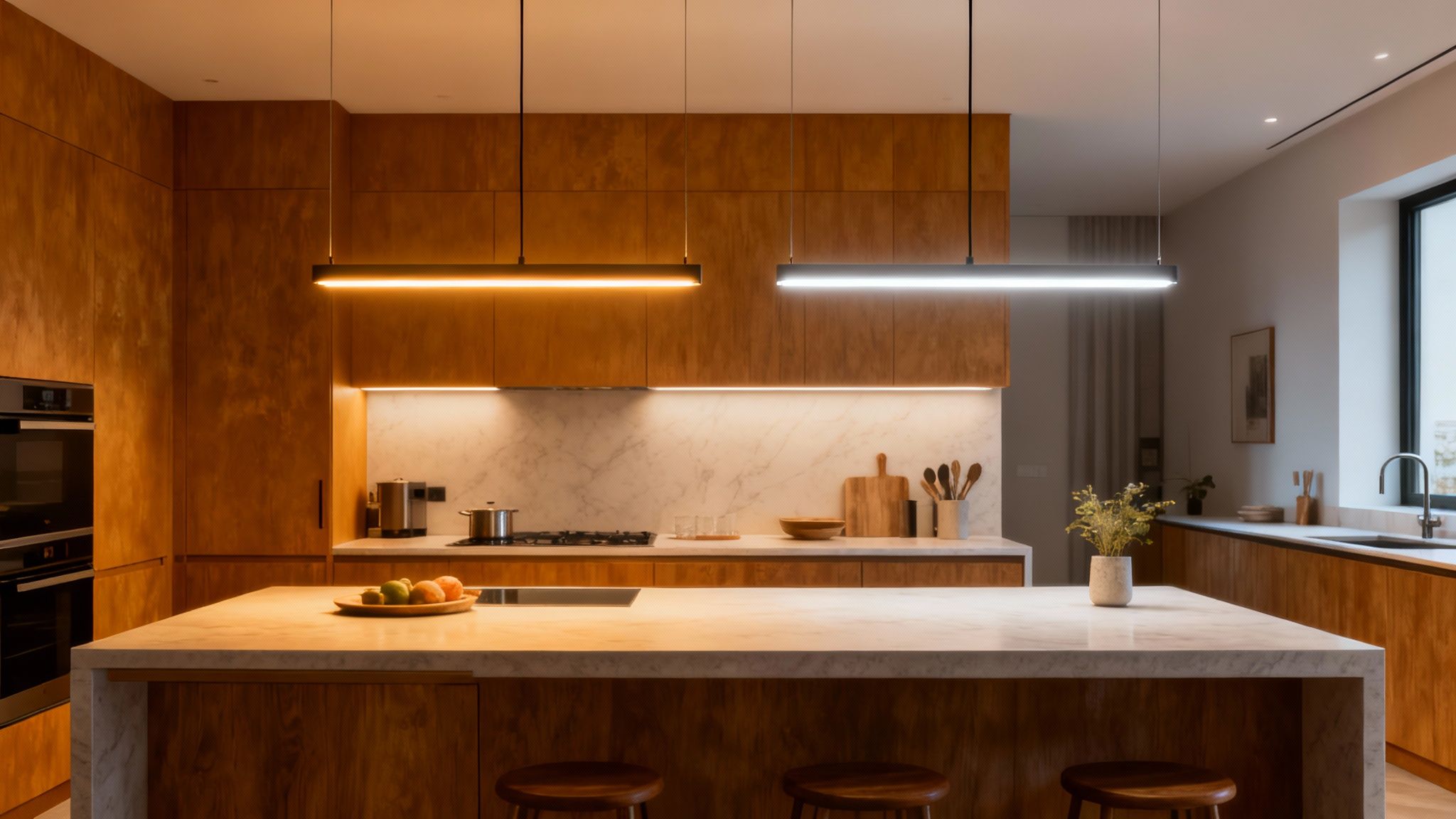
Choosing the perfect fixture is a huge step, but the real magic comes from the bulb you put inside it. This is where we get into the nitty-gritty of creating the right atmosphere, moving beyond just looks. The two words you need to know are lumens (for brightness) and Kelvin (for colour).
It sounds technical, but it’s actually quite straightforward. Lumens simply tell you how bright a bulb is – more lumens, more light. Kelvin, on the other hand, describes the colour of the light, from a warm, yellowy glow to a crisp, cool blue.
Finding Your Ideal Colour Temperature
The Kelvin scale is your secret weapon for setting the mood in your kitchen. Get this right, and you'll create a space that feels exactly how you imagined.
- Warm White (2700K – 3000K): Think of the soft, yellowish glow of an old-fashioned incandescent bulb. This light is incredibly inviting and works wonders for creating a cosy, relaxed atmosphere in traditional, farmhouse, or rustic kitchens.
- Cool White (3500K – 4100K): This is a much brighter, more neutral white light that feels crisp and clean. It's a great choice for task-heavy spaces and really complements sleek, modern, or minimalist kitchens where you want clarity.
- Daylight (5000K and above): This light has a distinct bluish tint that mimics bright daylight. While it’s fantastic for a workshop or a garage, it can often feel far too harsh and clinical for a living space like a kitchen.
For most homes, a warm white light around 3000K is the sweet spot. It’s bright enough for chopping vegetables but still has that welcoming, homely feel. Of course, the look of the bulb itself matters too. We have a great guide on choosing the best decorative light bulbs that will really elevate your fixture's style.
Calculating the Right Brightness
Now, let's talk lumens. Your kitchen island is a proper workspace, so it needs solid task lighting. A good rule of thumb I always use is to aim for around 700-800 lumens for every square metre of your island.
So, for a typical 2-metre by 1-metre island (that's 2 square metres), you'd be looking for a total of 1,400 to 1,600 lumens. You could easily get this with three pendants that each give off around 500 lumens. It's clear people are investing more in getting this right; the UK market for ceiling lights and chandeliers, which includes island fixtures, generated revenues of roughly USD 838.75 million in 2025. You can discover more insights about the UK lighting market on Statista.com.
Honestly, the best investment you can make is a dimmer switch. I consider it a non-negotiable for kitchen island lighting. It gives you complete control – full brightness for meal prep, then a soft, dimmed glow for a quiet evening drink. It makes the space truly versatile.
Matching Light Fixtures to Your Kitchen Decor
Think of your island lighting as the perfect piece of jewellery for your kitchen. It’s that final, brilliant touch that pulls the whole room together. Choosing a fixture is about so much more than just how bright it is; it’s about finding a piece that really sings with your home’s personality and elevates your decor. The right light can either harmonise quietly or stand out as a stunning focal point.
The secret is to create a cohesive design story. Now, this doesn’t mean a perfect matchy-matchy look. Instead, you want all the elements to feel connected. A simple trick I often suggest is to mirror the finishes. If you’ve got brushed brass cabinet handles and a tap to match, choosing pendants in a similar warm metal will create a beautifully layered, intentional feel.
Aligning Lights with Popular UK Styles
There's so much inspiration to be found in current UK design trends. By aligning your lighting with your kitchen's overall aesthetic, you can create a space that feels effortlessly stylish and put-together.
Scandi-Inspired Kitchens: These spaces are all about warmth, simplicity, and natural textures. I’d recommend looking for pendants made from light-coloured wood, bamboo, or even rattan. The woven material casts a beautiful, diffused light and adds a wonderfully organic, calming vibe.
Industrial and Urban Spaces: If your kitchen features exposed brick, concrete worktops, or Crittall-style doors, you can afford to be bold. Fixtures in matte black, aged brass, or burnished copper make a real statement. Pendants with exposed bulbs or metal cage designs are perfect for finishing off that raw, utilitarian look.
Modern and Minimalist Kitchens: For sleek, uncluttered kitchens, the lighting needs to be just as clean. A slim linear suspension light in a neutral finish like white or brushed steel offers great, even light without visually cluttering the space. You also can't go wrong with simple glass globe pendants.
Your island light is one of the few elements in a kitchen that can be purely decorative. While it still needs to be functional, don’t be afraid to pick something with a bit of personality that you truly love. See it as a chance to hang a piece of art in a very practical space.
Creating a Cohesive Design
Getting that harmonious look is all about sweating the small stuff. The finish of your lighting for kitchen islands should really complement other metallic elements you have, like your appliance accents or even the legs on your bar stools. This creates a subtle visual thread that ties the whole room together.
For example, a matte black pendant can cleverly echo the black frames of your windows or the finish on your oven, creating a sophisticated and coordinated design. If you're ever stuck on how to pull these little details together, our guide to easy styling tweaks that instantly refresh any room has some great, practical advice.
Ultimately, whether you go for a dramatic, sculptural chandelier that commands attention or a series of understated pendants that let your worktop be the star, the goal is the same. Your lighting should feel like a natural extension of your kitchen’s character, completing the space with both style and purpose.
Common Questions About Kitchen Island Lighting
Choosing the perfect lighting for your kitchen island usually brings up a few last-minute questions. To help you lock in your plans with confidence, let's walk through some of the most common things people ask when they get to the design and installation stage.
Nailing these final details is what makes your new lighting not just beautiful, but genuinely functional for your daily life.
How Many Pendants Should I Put Over My Island?
Honestly, this comes down to the size of your island and the pendants you've chosen. A good rule of thumb for an average-sized island—say, around 2 metres long—is to use two or three pendants. If you're working with a smaller island, one or two might be all you need.
The real goal here is visual balance. You want the light spread evenly without making the area feel cluttered. A big factor is the diameter of your fixtures. Larger, more dramatic lights need more visual breathing room, so you’ll naturally use fewer of them.
Can I Mix Different Lighting Styles Over My Island?
You can, but it’s a very tricky look to pull off well. Hanging different styles of pendants directly over the same island can often look a bit messy or accidental. A much safer—and usually more effective—approach is to keep your main island fixtures consistent.
For instance, stick with a cohesive set of matching pendants. You can then build a layered lighting scheme around them by adding different types of light elsewhere. Think recessed spotlights in the ceiling or discreet under-cabinet task lights. This creates a much more polished and intentional design.
The most successful kitchen designs feel deliberate. Sticking to one style for your main island fixtures gives you a strong anchor point, allowing other lighting layers to complement it without competing for attention.
What Is the Best Way to Clean My Light Fixtures?
How you clean your fixtures depends entirely on what they're made of. First things first: always make sure the power is off and the bulbs are completely cool before you touch anything.
- Glass Fixtures: A soft microfibre cloth and a spritz of glass cleaner will do the trick.
- Metal Finishes: For materials like brass or matte black, a quick wipe with a dry, soft cloth is usually enough to handle dust and prevent water spots.
- Greasy Metal: If you've got some kitchen grime on a metal fixture, use a slightly damp cloth, then dry it immediately to avoid streaks.
- Natural Materials: For things like rattan or wood, a simple dusting with a soft brush is all you’ll need to keep them looking fresh.



